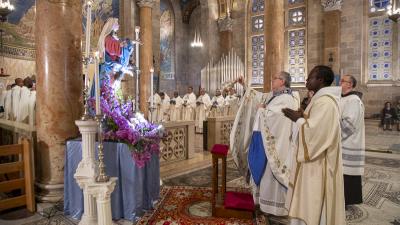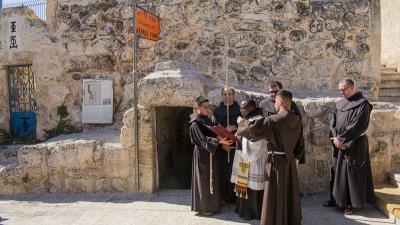
The organ resonates within the walls, and the priests process in with their white robes, while pilgrims wait standing up: the Easter Triduum begins at the Holy Sepulcher. The Mass of the Lord's Supper on Holy Thursday kicked off the celebrations leading up to Easter right at the Basilica of the Resurrection. More than two hundred priests participated in the liturgy that commemorated the institution of the ministerial priesthood and the love with which Christ loved his disciples so as to wash their feet. This symbolic gesture was repeated at this mass, during which the Apostolic Administrator, Fr. Pierbattista Pizzaballa, washed the feet of six seminarians and six Franciscan friars. Another important sign of this celebration was the blessing of the holy oils for the sick, the catechumens and the priests.
“We are here as the Church of Jerusalem, and I say it with a new type of emotion on my first Holy Thursday as a Bishop,” Pizzaballa said in his homily. “I'm with you as a disciple, but also as a bishop, to turn this diocese into fragrant bride ready for the Bridegroom who is coming.” The priests renewed their priestly vows, still reflecting on the words they just heard from Pizzaballa: “Do not forget that we were born in the Upper Room, and we were anointed with chrism, and that the Eucharist was entrusted to us. We are the ministers of a God who is on his knees, and who was sent to serve and heal; [we are] priests who not only give, but who give of themselves as a sacrifice for the life of the world.” After the long procession, after circling the Edicule three times, and after placing the Blessed Sacrament back in the tabernacle, the congregation left without a final blessing. Outside of the cool temperatures of the Holy Sepulcher, under the warm morning sun, the pilgrims passed by with joy in their eyes. Like Fernando, a seminarian from Ecuador, “Before I used to read the Gospel and know the places because of the Scriptures. Now I am at the places that I have always heard about.”
The pilgrimage to the Upper Room
The Holy Thursday celebrations did not end here. Indeed, they only just began. In the afternoon, after the delivery of the key of the Holy Sepulcher to the Vicar of of the Custody, Fr. Dobromir Jazstal, the pilgrimage to the Upper Room took place. A cheerful crowd gathered in front of Saint Savior’s, as they waited for the friars. They spoke many languages, and pilgrims mingles with locals. With the arrival of the Custos, the group set out behind the Kawas. The first stop was the very crowded Upper Room.
The children from the Jerusalem parish and their families were already sitting in the place where Jesus had the Last Supper with his Apostles. In the dim lighting, the camera flashes lit up the faces of pilgrims that were crowding in every direction. The Custos washed the feet of the children, once again recalling the rite performed by Jesus at the Last Supper. A mother excitedly told everyone: “My son is there among those children!” While Janette observes her grandchild, while softly saying, “There is so much excitement here, with all of these people! There he is!” After the reading of the Gospel according to John, the Custos invited those present to say an Our Father, each in their own language. Thus, all of the mixed up languages became one voice with the same meaning. It is only seemingly incomprehensible.
From the Upper Room, the procession moved to the Armenian Church of St. James. On the way, while walking briskly, the Custos said, “The Last Supper is precisely the place where Jesus washed the disciples’ feet, and this gesture reflects the significance of his Passion. We remember that the Upper Room is also the place of the institution of the Eucharist.” From Saint James’, the group made its way through the inner streets to the walls of the Armenian monastery in order to reach the small Church of the Holy Archangels. Here the Vicar, Fr. Dobromir recalled the reason for this stop: “These places are dear to us friars. As we know, in 1551, the Franciscans were kicked out of the Upper Room, and having no other place to go, they were welcomed by the Armenians here for six years.”
[After this,] there was just enough time for a Pater Noster and everyone departed once again. The sound of the Kawas’ sticks also led the last few pilgrims that were straggling behind the rest of the group. The Syrian Orthodox Church of St. Mark’s was the last stop before returning to Saint Savior’s
How can we not give thanks to God?
The façade of the Basilica of Gethsemane was lit up for the vigil of the Holy Hour. Inside, the pilgrims sitting on the floor whispered, prayed or looked at the beautiful mosaics that sparkled with all of the different colors.
The prayer vigil, presided over by Fr. Francesco Patton, the Custos of the Holy Land, was about to start. During this Holy Hour, the faithful were invited to keep vigil, pray and meditate on the three main moments that took place at this very place: Christ's prediction of Peter's denial and the flight of his disciples, his agony in the garden and finally his arrest.
When the evening was over, the faithful gathered and on the forecourt of the church and on the street where traffic had been interrupted, so that they could begin the procession to St. Peter's in Gallicantu. The procession advanced in the candlelight and to the sounds of the melodies and songs. “We are part of the people who started this procession in 2000,” said Issa Majlaton, who is a member of Saint Savior’s choir. “With the parish, there were only fifty [of us] at the beginning. After all of these years, seeing the large number of people participating makes us happy. These people, young and old, come, walk together and pray. Tonight, all around us, we can see and feel that God’s Word is always in our hearts, how can we not give thanks to God?”
The pastor of Bethlehem, Fr. Rami Asakrieh, accompanied five tour buses from his parish, and he emphasized the importance of their presence and explained their journey. “Yes, we are lucky enough to come from the birthplace of Jesus Christ, Bethlehem, but the history of salvation must be continued until his crucifixion and Resurrection. We are here to continue the journey with Jesus, to grow with the Gospel, and to lift our souls by walking where Christ walked.”
Christ’s suffering is each of ours, explained Souheil Asfour, who is also a member of the choir, a suffering by which Jesus gets closer to us but by which we are especially lifted up. If Christ has suffered, it means that all of our sufferings today have a deep meaning in all of the spheres of our lives, because after all of the suffering there is resurrection.”
For now, the silence of the arrest, the meditation on our betrayals can be placed in the gardens of St. Peter in Gallicantu.
Beatricie Guarrera - Arianna Poletti - Nizar Halloun
Holy Wednesday from Gethsemane to the Holy Sepulcher
In Bethany, Holy Monday is celebrated at the “House of Friendship”
Palm Sunday at the Holy Sepulcher and on the streets of Jerusalem




